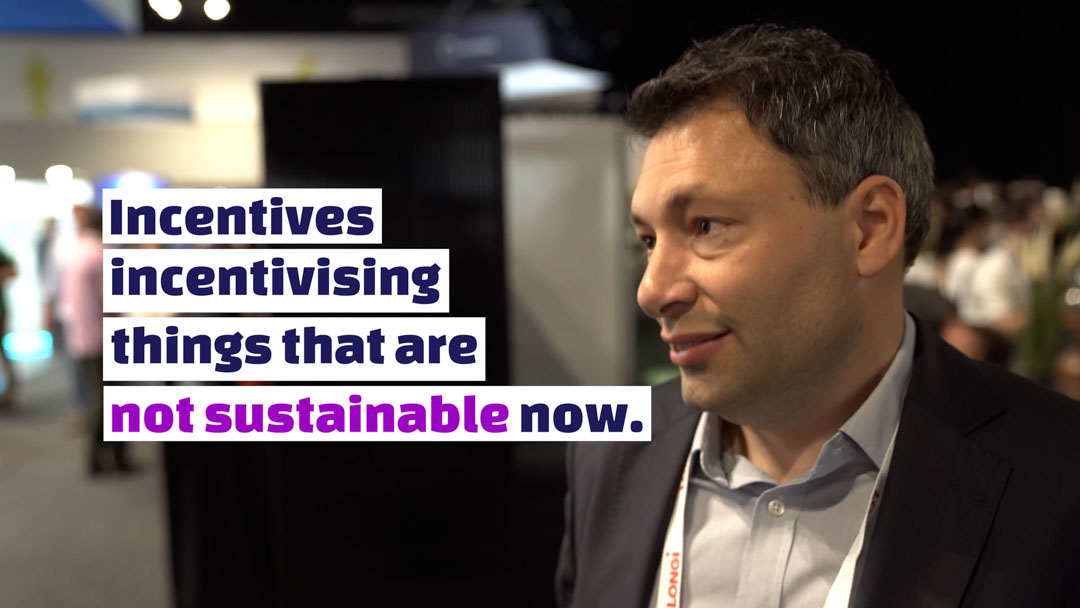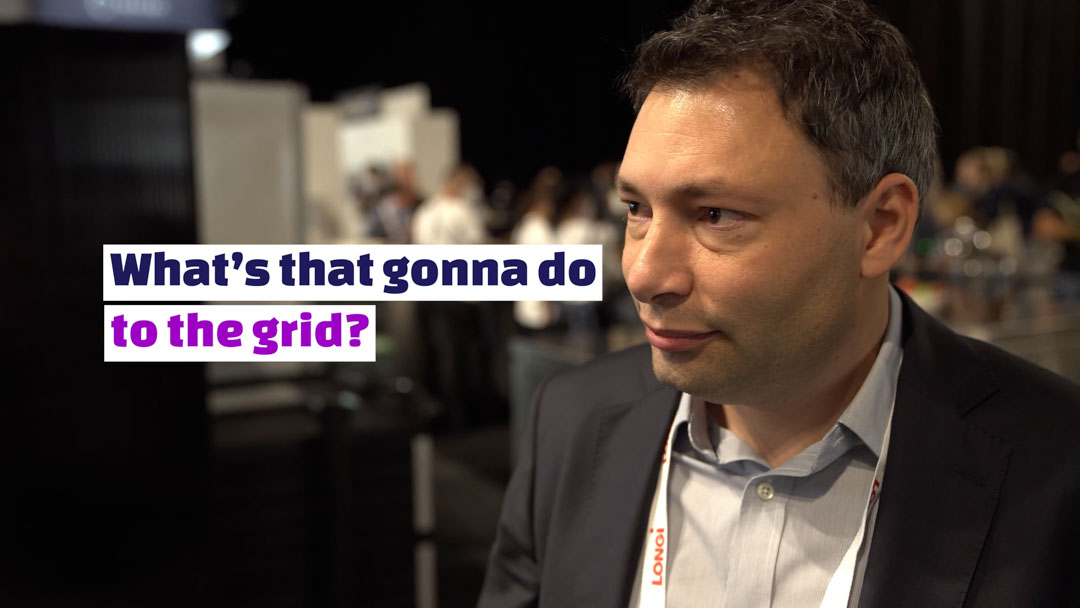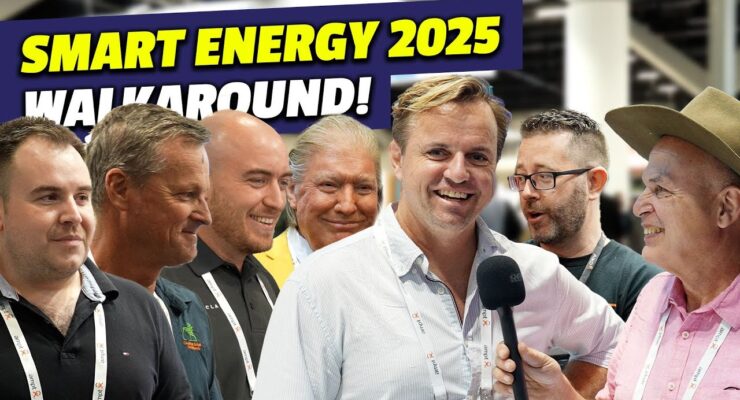
Fast read
We had some questions about the future of solar and grid energy, so we spoke to Dean Spaccavento from Reposit.
The two main points we took away were:
- Current government policies favour those individuals on the upper-end of the spectrum with regressive taxes and unsustainable incentives.
- With the influx of electric vehicles creating stronger pressure on energy requirements, we must look to off-grid solutions to limit opportunities to overuse grid energy.
Controlling the grid of the future
I spoke to Dean Spaccavento from Reposit at the recent Smart Energy event. Dean is a very smart guy. He knows about virtual power plants and how we connect to the grid.
But as with smart guys, sometimes you got to translate. You really got to simplify it.
Markus Lambert: Okay, Dean, you’ve been in the industry for ten years now, and you know a bit about virtual power plants and how it’s all going to be in the future. I have no idea what will happen in the future. I just think there’s a solar system on a roof. But then they got to go in the grid, and after that, I’ll forget about it.
Dean Spaccavento: We knew it would happen eight years ago, that lots and lots of solars would come into the system. We could see the price curves, and as a result, we knew there was going to be a problem with uncontrolled solar. So, we tried to basically say to people, well, controlling your solar is important.
Markus Lambert: So what Dean is really saying is that we make a lot of electricity with solar during the middle of the day because our manufacturing has slowed down. We don’t need that much energy in the middle of the day so that energy has somewhere to go. Maybe that means really in the future, we need more batteries to absorb the solar that we generate, mostly in the middle of the day.
How are our current solar policies favouring those in middle-to-upper class wealth?
Dean Spaccavento: You know, uncontrolled solar requires larger amounts of the network to be able to absorb, and that’s going to cost money. That’s what’s happening.
There will be a price signal imposed on solar. That will cause solar to have controllers put on them because either it’ll be a negative wholesale price. This will mean that you have to pay to generate.
Otherwise, there’ll be a price associated with delivering energy to the grid as the grid has to be built up a bit to be able to take that energy. Now it won’t be like building the grid again.
Markus Lambert: So what Dean is saying here is that maybe the inverters have to stop exporting that solar into the grid. Otherwise, somebody has to pay for the new capacity of the grid to absorb all that electricity with additional storage, whether battery or whatever. But somebody will have to pay for it.
Dean Spaccavento: The problem is that people who can afford solar are typically those people with a bit of money in their pocket. These people are those with detached houses who are, you know, at the middle to upper end of the wealth spectrum.
Poorer people are getting shafted because they can’t afford solar.
Still, they have to pay for the electricity costs of the network being built out. Electricity at the moment in this country is a regressive tax. It’s bad for poor people and is neither sustainable nor fair.
Markus Lambert: Somebody has to pay for the new capacity of the grid to absorb all that electricity with additional storage, speed, battery or whatever. But somebody will have to pay for it.

What does the Australian Government currently think of the situation?
Dean Spaccavento: Oh, my God, solar had a free ride?! The incentives are entirely in the wrong places. We see the effect of incentives incentivising things that are not sustainable now. We are seeing it with minimum demand issues in South Australia. We’re about to see it with minimum demand issues in Victoria. We see the regulators and regulators get stroppy with that.
We’re seeing rubbish like: let’s turn solar off in South Australia, which is a knee-jerk, sledgehammer, no subtlety solution. Right.
The correct answer is negative wholesale prices and NSCAS contract to keep synchronous services in the grid. That is the correct answer, yet not what the South Australian Government did. Absolutely incorrect.
Markus Lambert: Were you confused, too? I mean, Dean is really saying that the South Australian government came up with this harebrained idea to charge solar owners in the middle of the day for the solar that they want to export.
Otherwise, they want to basically stop them from exporting altogether. But what he really believes also is that there should be a price mechanism that reflects those realities for the large energy generators.
So an example is a large energy generator. On a sunny day, you do not generate much electricity in the middle of the day when the solar on the roofs already generates that electricity. So it’s actually the large generators that have to build in that flexibility.
Dean Spaccavento: However, you know, heavy-handed government responses are what’s coming for everybody. This is unless we get our s*** together and start to control these people.
Markus Lambert: Now, you’re saying there’s enough solar in the system that the grid cannot handle on some days. Yet ironically, we’re still giving a Federal Rebate to put more solar in the system.
Dean Spaccavento: That’s true! Also, the Federal Rebate, as everyone knows, pays for the panels and the racking now.
The incentives are all over the place because, as you say, right
Solar is middle-class welfare.
The middle class are the majority of the voters in this country. The Federal Government is not going to do anything to raise their eye ire.
I mean, I’ve got a statistic that there was a big energy retailer who dropped the feed-in tariff and lost 28,000 customers in a week. I mean, that’s insane. However, it shows you the sensitivity in these retail businesses around solar picking tariffs. Everyone knows people buy electricity on two things. What’s the discount rate on the consumption, and what’s the feed-in tariff rate? That’s it.
Markus Lambert: Now we are also going to get electric cars seemingly slowly, but they’re coming.
Dean Spaccavento: Yeah.

What is EV charging doing to the grid?
Markus Lambert: What’s that going to do to the grid?
Dean Spaccavento: It’ll make the nighttime surge worse. Unless all employers across the country deliver mass charging places, a large part of the fleet will not be plugged into the system, absorbing the solar in the middle of the day. They’re going to go home at night. They’re going to top up.
Markus Lambert: So then, where is that power coming from?
Dean Spaccavento: That power is going to have to come from other people’s storage or dispatchable generation of one sort or another. Snowy 2.0, Reposit batteries, who knows?
Markus Lambert: Coal?
Dean Spaccavento: I don’t so. I think coal is dead.
Markus Lambert: I don’t personally fully agree with that.
So Dean says here that we don’t have the infrastructure in place at this point to charge all these new electric vehicles during the day. Ideally, they would all be charged through solar or some kind of renewable infrastructure. If they do not, then everybody comes home at night and plugs the vehicle in and charges it. That means we need a lot of electricity, and this might even be coal-fired electricity.
He doesn’t believe so, but as it looks, we don’t really have the infrastructure right now. Maybe in five, six, seven, eight years, but not right now. So all these electric vehicles, if they just get charged with power that is generated through coal fire, then we’re actually not going ahead.
So it’s really a matter of the whole grid having to be redesigned, and massive investments have to go in there, and the government really has to have a vision for that.
What is the best solution in regard to electric vehicles in the future?
Markus Lambert: If we don’t watch out in regards to electric car charging, if we just let that go, pop and pop, then suddenly the grid will go down, and we will have blackouts because we got too many electric cars on the grid.
Dean Spaccavento: Absolutely, the electric cars need to be under control. The problem will be that they will all turn up at the same time. Then you just need to stagger the charging and how customers deal with that.
Markus Lambert: How do we do that?
Dean Spaccavento: I’m not sure. People will want their car full, or you know at least 85% or whatever. I don’t know how to deal with that problem. Other people like chargebacks work that s*** out, right? I just want to control the cars.
Markus Lambert: So ideally, if we want to charge the vehicles during the day, then employers have to have massive solar systems on their buildings, or they would have to source the electricity from big solar farms, maybe outside the cities, to then have that electricity available to charge the vehicles during the day. That might be a service that they supply to their employees.
Want more energy answers? Visit yourenergyanswers.com for quality energy products, tools and calculators and find your local installer.


